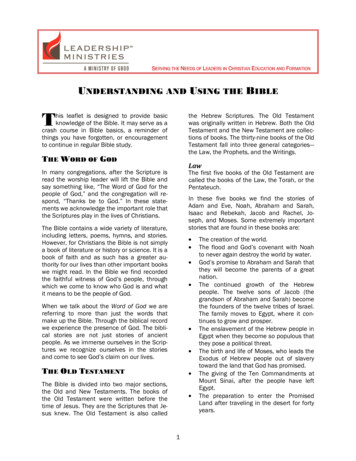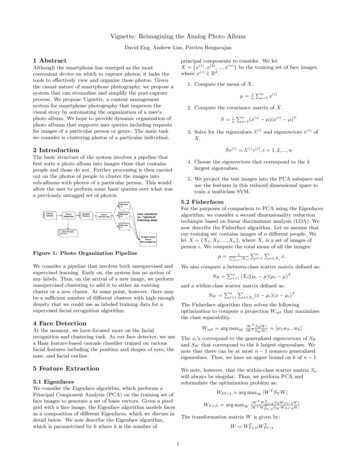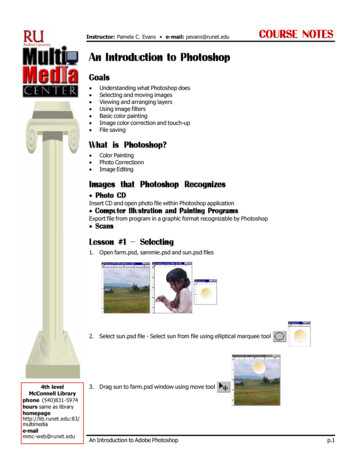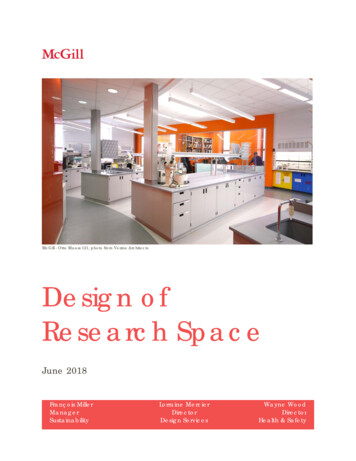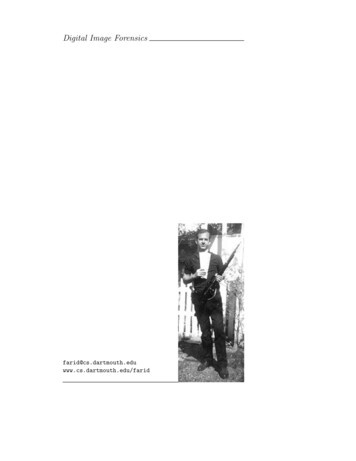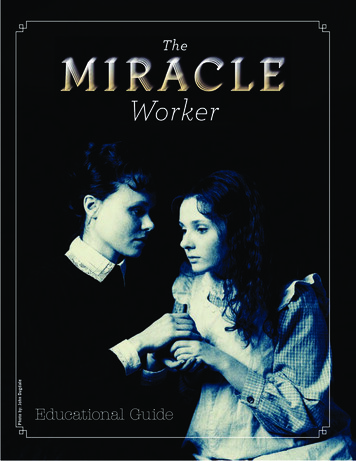
Transcription
Photo by: John DugdaleEducational Guide
Educational GuideWritten ByCara Costantini and Marty JohnsonContributing EditorsSusan Fuller, Lindsay WeinerProject ManagerSusan FullerDesigned ByDanielle Johnson and Kevin M. JohnsonCreated ByiTheatrics.comwww.miracleworkeronbroadway.com
TableTableTableof ContentsContentsofofContentsINTRODUCTIONHow to Use This Guide . 2A Letter From Keller Johnson-Thompson,Ambassador for the American Foundationfor the Blind in New York City . 3BEFORE THE SHOWABOUT THE SHOWPlot Synopsis . 4Character Descriptions . 6William Gibson, the Author . 7Adaptations of the Show . 7THE WORLD AROUND THE SHOWHelen Keller . 8Johanna (Anne or Annie) Sullivan . 9The 1880s . 10Notable Events . 10Inventions. 10The Role of Women . 10Medical Practices . 10Accessibility In the United States . 11American Sign Language . 11The American Foundation for the Blind . 12Things to Remember . 12AFTER THE SHOWTopics for Classroom Exploration . 13CONNECTING TO THE CURRICULUMA. Language Arts . 151. Poetry in Motion . 152. Describing the Unseen. 153. Louis Braille . 15B. Geography & History . 151. The North and the South. 15C. Mathematics . 161. The Price of Learning . 16D. Visual Arts . 161. Texture Collage . 16RESOURCESAdditional Resources . 17Helen Keller, circa 1902. Photo courtesy of the American Foundation for the Blind, Helen Keller Archives.amone.one.I cannotI cannotIIamdo doII amone, butbutstillstillam onlyonly one,everything,everything, butbut stillstillI can dodo something;andbecauseI cannotdo everything,and becauseI cannotdo everything,I willnotrefuseI willnotrefusetotododosomethingsomethingthatthatII cancan do.do. HelenHelenKellerKellerw w w.m i r a cle worker on br o a dw a y.c om 1
IntroductionIntroductionIntroductionHow to Use This GuideDear Teachers,Welcome to The Miracle Worker Educational Guide.These materials can serve as a catalyst for educationalenrichment beyond the performance.Inside this resource you’ll find a variety of activitiesthat may either stand alone or work in sequence as aunit of study. Feel free to photocopy pages from thisguide to distribute to your students. We have structured the guide into three sections: Before the Show,After the Show, and Resources.Helen Keller, circa 1893. Photo courtesy of the AmericanFoundation for the Blind, Helen Keller Archives.Never bendyour head.Hold ithigh.Look theThe first section, Before the Show, provides information about the production, some historical background,and additional information. The second section, Afterthe Show, features activities and discussion topics toexplore The Miracle Worker’s content in your classroom. Finally, the Resources section provides information for delving deeper into the world of The MiracleWorker with websites, videos, and more.We hope this guide will inspire your students to furtherexplore the world of The Miracle Worker and all of itseducational riches. Enjoy the Show!worldstraight inthe eye. Helen Keller2 w w w.m i r a cle worker onbr o a dw a y.c om
A Letter From Keller Johnson-Thompson,Ambassador for the American Foundation for the Blind in New York CityWinston Churchill called her “the greatest woman of the twentieth century.” Mark Twain went even further, calling her “the most extraordinaryproduct of all the ages.”Helen Keller was born in Tuscumbia, Alabama, on June 27, 1880. At theage of 19 months she was stricken with a sudden illness that would leave herboth blind and deaf for the rest of her life.It was Alexander Graham Bell who put the Keller family in touch withthe Perkins Institution for the Blind, which arranged for Annie Sullivan tobecome Helen’s Teacher. With determination and compassion, Annie tookcharge of her student and led her into life, starting with that famous day atthe water pump when she spelled W-A-T-E-R into Helen’s hand.I always knew I had a special connection to Helen Keller. I was born inHelen Keller Memorial Hospital and named after my great-great-aunt. Iremember blindfolding myself with one of my mother’s scarves and puttingcotton balls in my ears to help me imagine what kind of world she must havelived in. After reading Helen Keller’s autobiography, The Story of My Life,when I was 9 years old, I realized that Helen Keller did much more thanlearn what W-A-T-E-R stood for. I was amazed to learn that a deaf-blindperson could learn to read, write, and speak in several languages. She wouldmeet 10 U.S. presidents, travel to 39 countries, receive the PresidentialMedal of Freedom, and the rich and famous would call her their friend. Shewas an author, activist and diplomat who fought for people on the marginsof society. It was the moment I realized that Helen Keller’s life was abouthelping others that I knew I would someday follow in her footsteps.Today, as Ambassador for the American Foundation for the Blind, I amfulfilling that dream. In this capacity—the same position held by my greatgreat-aunt—I share the message that Helen Keller’s life was not just aboutbeing deaf and blind. It was about overcoming incredible odds, sacrificing forwhat you really want in life, and leaving the world better than you found it.So powerful a symbol of triumph did she become that she has an indisputable place in the history of our time and of times to come. Upon her deathin 1968, Senator Lister Hill of Alabama expressed the feelings of the worldat the funeral services at the National Cathedral in Washington, D.C., whenhe said, “She will live on as one of the few, the immortal names not born todie. Her spirit will endure as long as man can read, and stories can be toldof the woman who showed the world that there are no boundaries to courage and faith.”w w w.m i r a cle worker on br o a dw a y.c om 3
Before the ShowAbout the ShowAnne Sullivan Macy (seatedright) manually signs intoHelen Keller’s right hand,1899. Photo courtesy of theAmerican Foundation for theBlind, Helen Keller Archives.Plot SynopsisAct OneIn Alabama, during the 1880s, Arthur (Captain)and Kate Keller are relieved to hear their babydaughter, Helen, will live after a bout of fever andcongestion. However, they quickly discover Helen isunable to see and unable to hear. Five years later,Helen has grown to be a difficult child, prone toviolent tantrums as her only means of getting whatshe wants. The Keller household, in addition to theCaptain and Mrs. Keller, consists of James, Helen’solder half-brother; Mildred, Helen’s baby sister; AuntEv, and a handful of African-American servants andtheir children. As Helen’s behavior becomes moreand more unmanageable, Captain Keller considersputting Helen into an asylum. Kate and Aunt Ev convince him to seek help from doctors up north.The Keller family consults Dr. Anagnos of the PerkinsInstitute in Boston, Massachusetts, who decides tosend Annie Sullivan to work with Helen. As Annie andDr. Anagnos say their goodbyes, it becomes clear thatAnnie, only 20 years old, is actually a former pupil atthe Perkins Institute, not a teacher. We learn in a flashback that when Annie was 9 years old, her younger4 w w w.m i r a cle worker onbr o a dw a y.c ombrother, who used crutches, was taken away from her.When Annie arrives at the Keller home, they aresurprised by her young age and that she has a visualdisability. Annie is partially blind, but as a result ofmany surgeries is still quite sensitive to light andwears glasses. Also surprising to the Kellers areAnnie’s northern mannerisms, which strike the family as peculiar and unladylike.In Annie’s first interaction with Helen, she takesthe girl to her room and gives her a doll. Spellingout the word “doll” in sign language on Helen’spalm, Annie’s goal is to teach Helen that objectshave names, and she can use those names to “see.”Helen rejects this lesson when she isn’t instantlyThink About It In Act I and again in Act III, Annie commentsthat, “I think God must owe me a resurrection.”What does she mean by that? Why do you think William Gibson decided to endAct II with Annie singing the lullaby “Hush,Little Baby?”
gratified with what she wants. In a fit of rage, Helenlocks Annie into the room and runs out of the housewith the key. James sees Helen do this, but ratherthan stop Helen, he allows the prank to ensue. Hourslater, Captain Keller angrily helps Annie leave herroom through the window and down a ladder. As therest of the family storms in to have dinner, Anniewatches as Helen, thinking she’s alone, removes thekey from her mouth and drops it down the well.Act TwoDuring dinner, Annie observes how Helen isallowed to walk around the table, using herhands to take whatever food she wants fromeverybody’s plate. The family allows this since it’seasier than dealing with one of Helen’s tantrums.When Helen attempts to take food from Annie’splate, Annie doesn’t allow it. In a controversial confrontation, Annie insists that the family leave theroom. Annie then locks herself and Helen in thedining room. James supports Annie’s radical behavior, but Captain Keller is appalled and decides heis going to fire Annie. After a violent struggle andseveral hours, Annie leaves the dining room andannounces that Helen has learned to sit by herself,eat with her spoon, and fold her napkin. Inspired bythis success, and recalling a time when Helen wasyounger and tried to say “water,” Kate persuades theCaptain to let Annie stay.Meanwhile, Annie realizes she will not be ableto help Helen as long as she is coddled by her family. Annie exposes more of her past to the Kellers,describing how she and her brother lived in an asylumwhere they were maltreated and surrounded by deathand dementia. After some negotiating, the Captainagrees to move Helen and Annie into a garden houseon their homestead for two weeks, where they arepromised to be uninterrupted by the family.Unhappy and confused, Helen moves into thecabin. Annie works, along with the help of Percy, theson of the Keller’s cook, to finger spell vocabulary toHelen. Annie believes that, just like a baby, as long as“Thebestin theandHelen is inundated with language she will soon learnto connect words to their objects and feelings.Act ThreeThe two weeks pass. Annie teaches Helen to bemore disciplined and well-behaved but has notbeen able to teach her that words represent ideas.Frustrated, Annie begs for more time, but the Captainand Kate insist Helen come back to the house.At dinner that night back in the main house, Helentests her boundaries and reverts to some spoiledbehaviors. The family is so happy to have Helen back,they allow her to get what she wants when she throwsa tantrum. Annie scolds the Kellers for “unteaching”Helen, but the Kellers feel Annie is expecting too muchof her. James tries to interject on Annie’s behalf, but,as usual, Captain Keller belittles him. As the adultsstruggle about what to do with this situation, Helenruns out of the house. Annie starts to run after her, andthe Captain tries to stop her. James finally stands upfor himself and defends Annie, forcing his father to letAnnie run after Helen to continue her lesson.Once Annie is outside, she finds Helen at the waterpump. The miracle Annie and Helen so desperatelyneed finally takes place. Helen finger-spells “water,”showing she understands what the word “water” actually signifies. Helen then bursts forth with the fingerspellings for many words, realizing a word is a namefor an object or an idea. Annie has unlocked Helen’sthoughts by teaching her the gift of language.Think About It In Act III, James gives a grace at the table thatAunt Ev finds odd. If the grace represents a metaphor for the characters in the play, who do youthink is Jacob? Who do you think is the angel?most beautiful thingsworld cannot be seenor even touched— they must be felt with the heart.” Helen Keller, as an adultw w w.m i r a cle worker on br o a dw a y.c om 5
Character DescriptionsAlison Pill (left) and Abigail Breslin (right)(Characters Listed in Order of Appearance)Captain Arthur Keller: a proud southerngentleman, father to Helen and James,husband to KateKate Keller: a well-mannered southern gentlewoman, Helen’s mother andJames’s stepmother, Captain’s wifeDoctor: examines Helen as a baby andclaims she is completely healthyHelen Keller: loses her ability to hear andsee due to an illness as a baby, gets whatshe wants through violent outburstsMartha and Percy: the children of the cookon the Keller homesteadAunt Ev: Helen and James’s aunt who liveson the homestead6 w w w.m i r a cle worker onbr o a dw a y.c omJames Keller: a young man who is oftenignored or chastised by his father, Jamesis still forming a relationship with hisstepmother of about six years, Kate KellerDr. Anagnos: runs the Perkins Institutein Boston where he helps children withvisual disabilitiesAnnie Sullivan: a 20-year old woman fromBoston with low visionBlind Children: children at the PerkinsInstituteBoy’s Voice/Jimmie: Annie’s younger brother, Jimmie, only seen in flashbackOffstage Voices: patients at the hospitalwith Annie and JimmieViney: a cook at the Keller homestead
“She islike a little safe,locked, that no one can open.Perhaps there isa treasure inside.” Anagnos, The Miracle WorkerAdaptationsof the ShowIn 1962, The Miracle Worker was adapted into a fulllength film. Anne Bancroft and Patty Duke reprisedtheir Broadway roles for the film, starring as AnnieSullivan and Helen Keller, respectively. In 1979,The Miracle Worker was re-produced as a televisionmovie. Patty Duke took on the role of Annie Sullivanthis time, and Melissa Gilbert played Helen. In2000, The Miracle Worker was again made for television featuring Hallie Eisenberg and David Strathairnas Captain Keller.Helen Keller and AnneSullivan Macy, 1893. Photocourtesy of the AmericanFoundation for the Blind,Helen Keller Archives.Think About It William Gibson,the AuthorOn November 13, 1914, William Gibson was bornin the Bronx, New York. After graduating from theCity College of New York in 1932, William movedto Kansas to study theater. His first plays, A Cry ofPlayers and Dinny and the Witches, were producedin 1948. In 1958, Gibson received critical acclaimfor his Broadway success, Two for the Seesaw. Thissuccess allowed him to garner support for his petproject, The Miracle Worker. Gibson first envisionedThe Miracle Worker as a solo dance piece, but laterwrote it as a teleplay for the CBS series Playhouse90. Gibson adapted the script for the stage in 1959.In 1960, The Miracle Worker received a Tony Awardfor Best Play.- Captain Keller remarks to his wife that“[they] certainly rear a peculiar kind ofwoman in the north.” Why does CaptainKeller find Annie so peculiar? Compareand contrast Annie and Kate.- Annie remembers her brother, Jimmie,asking her to stay with him “forever andever.” Why is this quote so significantto Annie?- Water is often used in literary imagery.Why is it significant that the first wordHelen understands is “water?”w w w.m i r a cle worker on br o a dw a y.c om 7
The World Around the ShowHelen KellerH“I long toaccomplish aandgreatelen Keller was born onJune 27, 1880 on theIvy Green plantation inTuscumbia, Alabama. Helen losther ability to see and hear whenshe was nineteen months old.With the help of her teacher, AnnieSullivan, Helen learned to use signlanguage and written languageto communicate.In 1888, Helen moved to thePerkins Institute for the Blind inBoston. In 1904, Helen Kellerbecame the first person withdeafblindness to earn a Bachelor ofArts degree when she graduated fromRadcliffe College.Helen used her love of languageto become a political activist andauthor. She was an out-spokensuffragette, pacifist, and socialist.Helen advocated for women’s rightsand helped to form the AmericanCivil Liberties Union. Helen foundedHelen Keller, circa 1896.an organization called Helen KellerPhoto courtesy of theAmerican Foundation for theInternational, to raise awarenessBlind, Helen Keller Archives.for vision research. She became aworld traveler, accompanied by herlifelong best friend, Annie Sullivan,to speak on behalf of people with disabilities.In addition to political activism, Helen wasan established writer, precociously writing herfirst work when she was only eleven years old.In 1903, she published her autobiography TheStory of My Life. By the time Helen died, she haddutypublished a dozen books.Since her death in 1968, Helen has receivedmany posthumous honors. She was awarded thePresidential Medal of Freedom and was inductedinto the National Women’s Hall of Fame. Her visage is seen on the Alabama state quarter, andhospitals, statues, and streets worldwide arenamed in her honor.noble task,but it is my chiefto accomplishsmall tasks as ifthey weregreat and noble.” Helen Keller, as an adult8 w w w.m i r a cle worker onbr o a dw a y.c om
“The mostimportant day I rememberin all my life is the oneon whichmy teacher,Anne Mansfield Sullivan, came to me.” Helen Keller, as an adultJohanna SullivanJohanna (Anne or Annie) Sullivan was born inAgawam, Massachusetts on April 14, 1866.At the age of three, Annie started to loseher sense of vision due to a bacterial infection. Her mother died of tuberculosis whenshe was eight, and her father subsequentlyabandoned her and her four siblings. Threeof her siblings were sent to live with different relatives. Annie and her brother, Jimmie,who had tuberculosis, were sent to TewksburyAlmhouse where the children endured horrifying circumstances. Jimmie died three monthsafter they moved to the institution.Annie was forced to live at Tewksbury forfour more years. While there, Annie underwent several eye surgeries, but none curedher blurred vision. In 1880, Annie attendedthe Perkins Institute for the Blind in Boston.There she had another surgery, which restoredpart of her vision. Annie graduated in 1886as valedictorian. The director of the PerkinsInstitute, Michael Anagnos, encouraged Annieto move to Alabama to become a teacher andgoverness to Helen Keller, a six-year old withdeafblindness.Annie and Helen became constant companions. The two lived together, along withAnnie’s husband, John Albert Macy. Johnand Annie married in 1905, but separatedin 1914. Annie and Helen traveled the worldadvocating for more research on vision, nutrition, and health. In 1936, Annie had a heartattack and went into a coma and died, withHelen by her side. Annie Sullivan’s ashes arein the Washington National Cathedral.Anne Sullivan Macy, 1894.Photo courtesy of theAmerican Foundation for theBlind, Helen Keller Archives.Anne Sullivan Macy manually signing into Helen Keller’sleft hand, circa 1893. Photocourtesy of the AmericanFoundation for the Blind,Helen Keller Archives.w w w.m i r a cle worker on br o a dw a y.c om 9
The 1880sThe Role of Womenhe Miracle Worker takes place in the late1880s during a time when the United Statesfelt a great cultural divide between the Northand the South. Northern industry grew more profitable, while in the South, farmers struggled to revivetheir economy in the aftermath of the Civil War. Thisdivide provided emotional momentum for women’ssuffrage and the socialist movement, both of whichhad a great impact on Helen Keller’s life.nown as “The Gilded Age,” this time periodwas the height of 19th century Americanwealth, but also a time of growing poverty.More and more poor or working-class women tookjobs to support themselves and their families outsideof the home.In the South, working-class women were permittedto work as teachers or as house servants. Since slavelabor was prohibited, many women took on doubleduties of running a household and helping to sharecrop. In the North, immigrant women and other working-class women typically worked in textile mills andfactories. They were paid less than men so employerswere willing to hire them. However, these women wereexpected to leave their work once they married.At the end of the 1800s as more women becameaccepted in traditionally masculine work places, likefactories and offices, fewer women took domesticjobs. And unlike their predecessors, many women inthe 1880s insisted upon receiving an education andenrolling in college. These newly educated womenbegan championing to better the lives of all women.TNotable Events: President Garfieldwas assassinated North Dakota, South Dakota,Montana, and Washington admitted to statehood Brooklyn Bridge openedto the public Statue of Liberty dedicatedin New York Harbor Debut of the automobilein Germany Inception of the Eiffel Towerin France Construction of PanamaCanal began Mark Twain published TheAdventures of Huckleberry FinnInventions: 10Ballpoint penDishwasherDrinking strawElectric fanKodak hand cameraPhonographCash registerTrolley carContact lensesKMedical PracticesWhen Helen Keller fell ill as a baby, the doctordiagnosed her as having congestion of thestomach and brain. Though she recoveredfrom this “congestion” she was left blind and deaf.Now, doctors believe Helen had either scarlet feveror meningitis.Scarlet fever is a streptococcal infection characterized by a rash and a high fever. In the 1880s,when Helen may have contracted this infection, therewas no way to treat it. In 1924, George and GladysDick developed a scarlet fever vaccine. Meanwhile,Alexander Fleming had discovered penicillin and bythe 1940s the scarlet fever vaccine was unnecessary. Strep infections could be easily treated with acourse of the penicillin antibiotic.Meningitis is the inflammation of brain and spinal cord membranes. Though still a serious illnesstoday, meningitis is often successfully treated with acourse of antibiotics. People are also able to receivea vaccine to prevent meningitis. In the 1880s,people who contracted meningitis typically died ashort time later.Other diseases that were common in the 19thcentury were cholera, smallpox, typhoid fever,tuberculosis, pneumonia, dysentery, diphtheria, andrheumatic fever. Nearly all of these illnesses were w w w.m i r a cle worker onbr o a dw a y.c om
fatal, but now these illnesses are preventable ortreatable. Immunizations and nutrition protect mostchildren in the United States from these diseases.If they are contracted, a standard course of antibiotics or rehydration treatments will generally flush outthe infections.Accessibilityfor People withDisabilities in theUnited StatesIinformation in braille, closed-captioning, and doorsand hallways wide enough to accommodate peoplewho use wheelchairs, walkers, or service animals.AmericanSign LanguageAn the 1800s, there was little advocacy in theUnited States for people with disabilities. Manypeople with disabilities, whether congenital or asa result of an illness or accident, were segregatedinto institutions. Though there were significant exceptions, such as the Perkins Institute for the Blind andGallaudet University, most people with disabilitieswere treated as invisible members of society.After World War I, attitudes toward people withdisabilities shifted. Assistive technology such as hearing aids, microphones, and amplifiers were developedand people with disabilities, particularly veterans, hadgreater involvement in their communities.In the 1960s, the Civil Rights movement reachedits peak. Doctors and therapists started to helppeople with disabilities engage in their communityrather than be institutionalized. The RehabilitationAct of 1973 protected the civil rights of peoplewith disabilities by guaranteeing equal employmentopportunities and access to public transportation. In1975, the Education for All Handicapped ChildrenAct provided every child the right to free education.In 1990, this educational act was renamed theIndividuals with Disabilities Education Act (IDEA)and more specific legal mandates were put in placeto maximize the success of all students.Also in 1990, Congress passed the Americanswith Disabilities Act (ADA). The ADA guaranteesthat public buildings and systems include assistivetechnology such as ramps, elevators, chair lifts,merican Sign Language was developed in theUnited States by Thomas Hopkins Gallaudet, aminister from Hartford, Connecticut. Gallaudettraveled to Europe where he was inspired by OldFrench Sign Language (OFSL). OFSL was developedby Abbe Charles Michel de L’Epee in 1755. L’Epeefounded a school for people who were deaf and usednatural hand gestures and finger spellings to help hisstudents communicate.Decades later, Gallaudet moved to Europe to studydeaf communication so that he could better help hisneighbor’s daughter who was deaf. After spendingsome time studying in England, Gallaudet moved toParis where he befriended Laurent Clerc, a sign language instructor. Gallaudet returned to Connecticutin 1817, where he and Clerc founded the first schoolfor deaf people in the United States. Gallaudet andClerc revised the language to include gesticulations,which were natural for Americans, hence the nameAmerican Sign Language (ASL). ASL, or Ameslan,is used in many deaf communities throughout theworld, including the Philippines, Malaysia, Kenya,Puerto Rico, and nearly 20 other countries.Think About It Countries outside of the United States have theirown sign language vocabulary. For example, theUnited Kingdom uses British Sign Languagewhich is completely different from ASL. ASL is the fourth most-used language in theUnited States.the world“Althoughit is also full ofisfull of suffering,the overcoming of it.” Helen Keller, as an adultw w w.m i r a cle worker on br o a dw a y.c om 11
The American Foundation for the BlindAnnie’s work with Helen Keller became the blueprint for education of children who were blind, deafblind, or have low vision. The foundation still continues their work today. The American Foundationfor the Blind website (www.afb.org) includes photos, letters, artifacts, audio-visual materials andfurther information on both Helen Keller andAnnie Sullivan. Use this site as a guide to learnmore about these two amazing women who arestill considered role models today.Things to RememberWhen You Meet or Speak to SomeoneWho is Blind or Has Low Vision. When speaking about a person with a disability, refer to the person first and then to the disability. For example, say “people who are blind” rather than “blind people.” Greet people who are blind right away when they enter a room. Make sure to use your name ifthey aren’t familiar with your voice. Speak directly to people who are blind or have a visual disability, not through their friend orguide. Do your best to refer to specific people or items by name instead ofgeneral terms like “you” or “they” or “this.” Offer to guide people who are blind or have low vision by asking if they would like assistance.They won’t always need assistance so respect their desires. For people who ask for assistance, allow them to take your arm justabove the elbow when your arm is bent and walk ahead of the personyou are guiding. Never grab a person who is blind or has low vision by the arm and push him/her forward. Never call or whistle to a guide dog or touch the dog’s harness or leash. Guide dogs are working animals and doing so can distract the dog.12 w w w.m i r a cle worker onbr o a dw a y.c om
After the ShowTopics for Classroom ExplorationAfter seeing The Miracle Worker, use the following prompts to discuss the themes,characters and context of the show. These prompts may also be used as essay topics.Communication1) Helen can not speak and therefore has trouble communicating with her family. What are somenon-verbal ways you communicate each day? Do you use signals in your classroom? Think about yourdaily routine. What other signals do you and other people in your community use to communicate?Expectations2) The Kellers are grateful Helen learns how to behave after spending two weeks in the garden house.However, Annie is disappointed, and feels Helen hasn’t learned enough because the child stilldoesn’t understand the meaning of words. Even though Annie is successful in some areas, shedoesn’t achieve all the goals she sets for herself. Is Annie being too hard on herself? Have you everbeen praised for one of your accomplishments but been disappointed because you couldn’t reach thegoal you had set for yourself? How did you deal with this? What does it mean to try your best?Family3) How do Annie’s memories of her younger brother Jimmie influence her behavior as an adult? How dothese memories assist her in working with Helen? Which other experiences from Annie’s past shapehow she works with Helen? Now think about your own experiences. What aspects of your background(family size, where you live) and experience (family trips, volunteering) influence the way you workwith other people? How do you feel this will change as you get older?4) Throughout the play, nothing James does seems to make his father happy. What are some of thereasons you think Captain Keller is so hard on James? Does James have a better relationship withhis stepmother, Kate?Abraham Lincoln, born in poverty and insecurity, rises up toone of the greatest characters in history.Franklin D. Roosevelt, inflicted with infantile paralysis,rises up to leave such an imprint that history books will beincomplete without his name.Helen Keller
Helen Keller Memorial Hospital and named after my great-great-aunt. I remember blindfolding myself with one of my motherÕs scarves and putting cotton balls in my ears to help me imagine what kind of world she must have lived in. After reading Helen KellerÕs autobiography, The Story of My Life, when I wa




